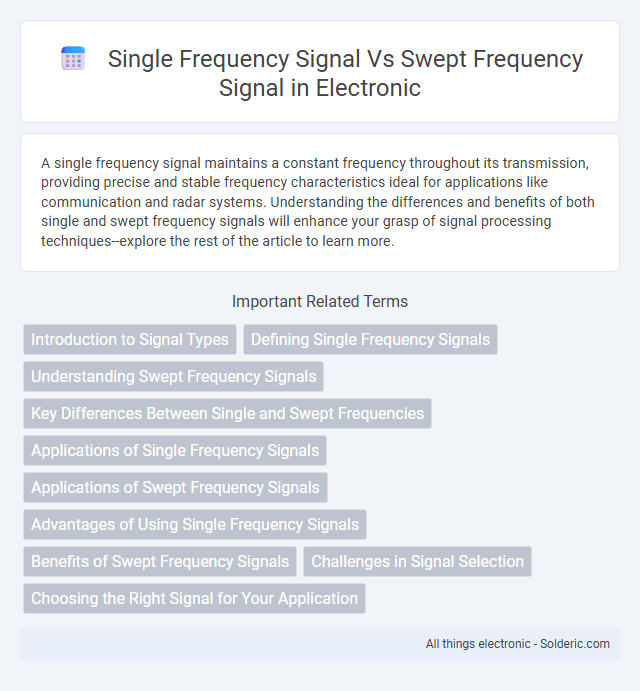A single frequency signal maintains a constant frequency throughout its transmission, providing precise and stable frequency characteristics ideal for applications like communication and radar systems. Understanding the differences and benefits of both single and swept frequency signals will enhance your grasp of signal processing techniques--explore the rest of the article to learn more.
Comparison Table
| Feature | Single Frequency Signal | Swept Frequency Signal |
|---|---|---|
| Definition | Constant frequency tone or wave | Frequency varies continuously over time |
| Frequency Range | Fixed, narrowband | Wideband, covers multiple frequencies |
| Application | Simple signal testing, narrowband communication | Radar, sonar, frequency response measurements |
| Signal Complexity | Low complexity | Higher complexity |
| Spectrum Analysis | Limited, single frequency point | Detailed, covers frequency sweep |
| Interference Sensitivity | High at single frequency | Less susceptible due to frequency variation |
| Measurement Time | Fast, instantaneous | Longer, depends on sweep duration |
| Bandwidth | Narrow bandwidth | Wide bandwidth |
Introduction to Signal Types
Single frequency signals maintain a constant frequency and amplitude over time, making them ideal for applications requiring precise frequency control and minimal spectral interference. Swept frequency signals continuously vary their frequency within a specified range, enabling effective analysis of system responses across different frequencies. These distinctions are fundamental in radar, sonar, and communication systems where signal type selection impacts resolution and detection capabilities.
Defining Single Frequency Signals
Single frequency signals consist of a constant frequency waveform, often represented as a sine wave with a fixed amplitude and frequency, ideal for precise measurements and system testing. These signals provide a pure tone without frequency variation, making them essential in applications like calibration, communication, and signal processing. Your ability to analyze system responses depends heavily on the stability and predictability of single frequency signals compared to swept frequency signals, which continuously vary in frequency over time.
Understanding Swept Frequency Signals
Swept frequency signals, also known as chirp signals, continuously vary their frequency over time within a specified range, enabling detailed frequency response analysis. These signals provide enhanced resolution in system identification and radar applications by capturing system behavior across multiple frequencies. Unlike single frequency signals that excite a system at one frequency, swept frequency signals offer comprehensive spectral information, improving accuracy in impedance measurements and material characterization.
Key Differences Between Single and Swept Frequencies
Single frequency signals maintain a constant frequency throughout, providing stable and precise measurements ideal for applications like tone generation and narrowband communication. Swept frequency signals gradually vary over a range of frequencies, enabling comprehensive frequency response analysis and detailed system characterization. These differences impact their use in diagnostics, with single frequencies offering simplicity and swept frequencies delivering broader spectral insights.
Applications of Single Frequency Signals
Single frequency signals are widely used in applications such as radar systems for accurate distance measurement, communication systems for stable carrier waves, and signal processing tasks like tone detection and filtering. They enable precise frequency discrimination in sonar and medical ultrasound imaging, facilitating clear and consistent signal analysis. Industrial automation systems also rely on single frequency signals for sensor calibration and control feedback loops.
Applications of Swept Frequency Signals
Swept frequency signals are widely used in radar systems, ultrasonic testing, and communication channels to analyze frequency-dependent properties and improve target resolution. Their ability to cover a range of frequencies allows precise material characterization, fault detection, and environmental monitoring. You benefit from enhanced system performance and data accuracy when utilizing swept frequency signals in applications requiring detailed frequency analysis.
Advantages of Using Single Frequency Signals
Single frequency signals offer precise and stable frequency output, ideal for applications requiring consistent signal characteristics such as communication systems and calibration processes. Their simplicity reduces hardware complexity and power consumption compared to swept frequency signals, enhancing system efficiency. Moreover, single frequency signals minimize interference and noise, improving signal integrity and clarity in measurement and transmission tasks.
Benefits of Swept Frequency Signals
Swept frequency signals provide enhanced resolution and detailed frequency response analysis by continuously varying the frequency over a range, enabling accurate identification of system resonances and anomalies. They allow for improved signal-to-noise ratio through averaging techniques, making them ideal for applications such as radar, sonar, and vibration analysis. This dynamic approach surpasses single frequency signals by capturing a comprehensive spectral signature, facilitating better diagnostics and system characterization.
Challenges in Signal Selection
Choosing between single frequency and swept frequency signals involves balancing trade-offs such as signal resolution, interference susceptibility, and complexity of implementation. Single frequency signals offer simplicity and stable frequency performance but face challenges in detecting multiple targets or distinguishing between close reflections. Swept frequency signals improve range resolution and target differentiation but require more sophisticated hardware and signal processing, increasing system complexity and potential susceptibility to frequency-dependent noise.
Choosing the Right Signal for Your Application
Single frequency signals provide stable, precise measurements ideal for applications like radar and communication systems requiring narrowband performance and low noise interference. Swept frequency signals offer broader spectral coverage, enabling detailed analysis in applications such as material characterization and ultrasound imaging by capturing frequency-dependent properties. Selecting between them depends on whether the priority is high resolution at a fixed frequency or comprehensive frequency response for signal analysis.
single frequency signal vs swept frequency signal Infographic

 solderic.com
solderic.com